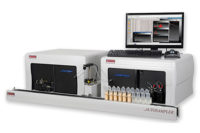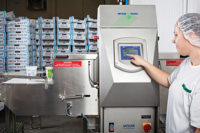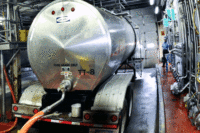
A 2010 consumer study sponsored by the Produce Safety Project at Georgetown University, Washington, D.C., found that health-related costs of food-borne illnesses total $152 billion a year, which includes the costs of medical bills, lost wages and lost productivity. That total is more than four times that of earlier estimates calculated by USDA and does not take into account food industry costs associated with a product recall.
Recalls occur not only for safety issues, but for quality reasons, too, and can be detrimental to a company’s bottom line. For example, a little less than a year ago, the Kellogg Co., Battle Creek, Mich., recalled 28 million boxes of select cereals after consumers complained that the boxes had an unusual smell and flavor, which the company blamed on a chemical in the box liner. Fallout from the massive recall resulted in a decline of 5% for North American retail cereal internal net sales in 2010. Kellogg might be able to handle this loss, but many small dairies would have to close up shop.
Parameters to monitor
There are several critical safety and quality control points that should be monitored within all dairy processing facilities. Some tests (i.e., antibiotic, somatic cell, adulteration, composition, etc.) are performed on each tanker delivering milk and also for each supplier on a regular schedule. Other tests (i.e., allergen detection, vitamin levels, etc.) are performed only within the context of production at regularly scheduled intervals. A few tests are performed throughout the dairy supply chain (i.e., milk composition, alkaline phosphatase, pathogens, etc.) to ensure quality, safety and sound nutritional value from farm to table.With an increasing number of consumers reading product labels, it is imperative that a product deliver what it promises. For example, dairy foods manufacturers must continuously monitor product composition of both raw materials and finished product. This is to ensure that the dairy foods consumers purchase deliver on the parameters specified on the Nutrition Facts and defined by the ingredient legend.
This is particularly important for bone-building nutrients that many consumers trust they are receiving from dairy foods, as not only is milk an inherent source of calcium, but FDA mandates vitamin A and D fortification of fluid milk. With vitamin A and D deficiencies recognized as serious medical concerns in the United States, ensuring sufficient delivery of these nutrients is a dairy processor’s responsibility.
Quality control testing is essential to ensure that milk delivers the right amount of these vitamins; too much is toxic and too little provides no benefit. An enzyme-linked immunosorbent assay (ELISA) testing kit that measures vitamin A and D content in fluid milk in as little as two hours is now available to quality control technicians. The testing of milk can now be completed before shipping, allowing adjustments to be made to prevent under- or over-fortification. The test is based on a proprietary rapid extraction process for the vitamins followed by quantification of vitamin content using proprietary monoclonal antibodies.
To avoid violating state and federal government regulations regarding total solids content of dairy foods, a new rapid, efficient gravimetric moisture and ash analyzer can assist. Using the accepted Babcock method for determining percent butterfat along with a gravimetric solids analyzer, lab techs can determine percent total solids, percent butterfat and percent solids-not-fat. The latter consists mainly of minerals, protein and lactose. The new gravimetric analyzer tests for non-organic material, mainly minerals, which allows for verification of calcium, phosphorus and potassium content. Further, the analyzer also measures water content, which is an important quality parameter, as excess moisture not only negatively impacts product appearance (i.e., syneresis), but it also can promote microbial growth and premature spoiling. Thus, quantifying moisture content helps determine product shelf life.
Introduced last year, another supplier offers a process analysis system based on high-resolution diode array technology. It provides non-destructive analysis of a variety of products, including dairy foods, directly in the process line without bypass. The analyzer is housed in a cabinet mounted at the relevant location in the production area. Measurements are displayed in the control room and results can be fed into a regulation system for closed-loop automatic control. The solution helps to optimize the use of raw materials and to consistently run production closer to target specifications.
Yet another supplier now offers an instrument designed for a wide range of component analysis, including fat, protein and lactose. The multicomponent analyzer uses an industrial Fourier transform spectrometer (FTIR) that captures the complete infrared absorption spectrum of the milk sample for component analysis. Collecting the complete spectrum allows the calibration to be based on all spectral characteristics of each particular component. The infrared spectrum is permanently stored so that at any time in the future, other calibrations may be retroactively applied to the data.
Control is integrated into a single Windows-based software program. Extensive diagnostics are collected so the user can be assured that the instrument was performing optimally when the sample data was taken. And because a full set of diagnostic readings is stored with each sample run, an audit trail exists to validate the state of the instrument during data collection. The system is engineered for dairy plants and laboratories that require a highly reliable and accurate instrument for performing individual tests on a variety of milk products.
Another new milk analyzer is designed for milk and cheese processors that require highly cost-effective dairy component analysis. The instrument uses a mid-infrared (MIR) filter to measure specific bandwidths for the most commonly measured dairy components in milk. Through access to specific software applications, dairy processors can use the analyzer to quantify fat, protein and total solids. The instrument processes up to 150 samples per hour, offers auto-cleaning and sample heating capabilities, and can be ordered with a freezing-point depression option.
A new low-cost, easy-to-use microprocessor measures both pH and titratable acidity. These two fundamentally different conventions for expressing acidity in dairy products are equally important to ensuring product quality throughout shelf life. Titratable acidity measures total acidity, while pH indicates the acid strength. This new microprocessor employs a titration method that has a potentiometric end-point determination at a pre-determined pH value. This eliminates the subjective end-point color-change detection determined by the human eye, and instead employs the sensitivity and accuracy of a pH sensor, eliminating the chance of error.
Let’s not forget that proper sanitation is vital to ensuring food quality and safety. If not removed by thorough cleaning, allergens, microorganisms and food residues can affect product safety and shelf life, which can lead to ingredient cross-contamination and recalls.
The presence of undeclared food allergens, in particular, has been the reason for numerous recalls this past year. A food allergy is typically an immune system response to a protein in food that the body mistakenly believes is harmful. Even minor exposure to a food allergen can cause symptoms from mild skin rashes to fatal anaphylactic shock.
Cross contamination during production can occur, so that residues of food allergens from different products show up in the most unlikely places. Rapid tests are now available for in-house labs to continuously check for allergens to ensure that contaminated product does not make it out of the manufacturing facility. Easy-to-use, accurate and affordable food allergen detection systems can be used on incoming ingredients, prepared foods, equipment and cleaning supplies.
In conclusion, suppliers are continuously working to develop increasingly sensitive tests to reduce the incubation time needed for end-product testing, as well as solutions that deliver the high-volume throughput required by large-scale processing facilities at an affordable price. Tests will continue to become more accurate predictors of safe, quality products for consumers.
Sidebar: Going Clean, Lean and Green in the Lab
Quality assurance and product safety professionals are increasingly turning to rapid microbial methods (RMMs) as a way to satisfy distribution deadlines while ensuring that only safe products are sent to market. A number of additional benefits of RMMs exist and should be considered in light of current industry trends toward sustainability, connectivity and the increasing conversion to aseptic packaging.Sustainability. Many food and beverage manufacturers overlook the micro lab when it comes to increasing their company’s sustainability profile. Many traditional testing methods generate large amounts of waste and can lead to increased water and energy usage. RMMs provide a sustainable alternative by completing tests faster and with less waste. RMMs allow products to be incubated, tested and released in as few as 24 hours - resulting in reduced inventory and warehouse space. And, a faster production cycle means products get to market faster.
Connectivity. Advanced software enables manufacturers to access test results for any product at any testing site with a network computer. This provides departments with the ability to view test results around the clock, improving visibility and increasing productivity. The software works by incorporating a multi-user interface that enables multiple RMM instruments to send results to a centralized location. In addition, the software that supports some of today’s new RMM systems helps companies simplify and streamline USDA and FDA compliance by allowing manufacturers to track and trace products and access data onsite or remotely.
Aseptic packaging. Many food and beverage manufacturers are embracing aseptic packaging in order to meet increased consumer demand for products that are natural, organic and free of preservatives. Compact and space-saving aseptic packaging also facilitates sustainability by utilizing less shelf and warehouse space, cutting shipping costs, reducing energy expenses, allowing delivery to more locations and even enabling the regular delivery of certain products to remote areas for the first time. Because the goal is to produce a sterile product, goods are far less likely to have any microbial bioburden present, meaning there is rarely a need to identify any organisms. A rapid screening, which quickly indicates the presence or absence of microbial contaminants, makes it easier to safely release the production run, while also enabling a faster response to contamination events.
Food and beverage manufacturers have relied on RMMs to deliver products to market safely and quickly for more than a decade. In today’s atmosphere of clean, lean and green, they make more sense than ever.
Source: Celsis Rapid Detection


